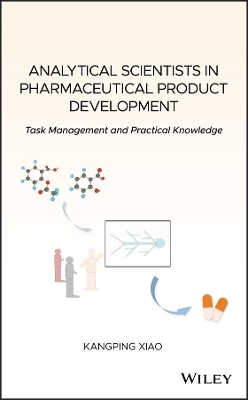
Analytical Scientists in Pharmaceutical Product Development
John Wiley & Sons Inc (Verlag)
978-1-119-54782-2 (ISBN)
Presents broad topics such as product development process, regulatory requirement, task and project management, innovation mindset, molecular recognition, separation science, degradation chemistry, and statistics.
Provokes thinking through figures, tables, and case studies to help understand how the various functions integrate and how analytical development can work efficiently and effectively by applying science and creativity in their work.
Discusses how to efficiently develop a fit-for-purpose HPLC method without screening dozens of columns, gradients, or mobile phase combinations each time, since the extra effort may not provide enough of a benefit to justify the cost and time in a fast-paced product development environment.
Kangping Xiao - Head of Analytical Development, Bayer Consumer Health R&D in NJ. His team plays critical roles in new product development such as the launch of Aleve PM, Claritin Cool Mint Chewables, and various Aspirin containing products globally. Bachelor of Science Wuhan University, Ph.D. University of Tokyo, Postdoctoral Michigan State University and University of Michigan.
Preface ix
1 Pharmaceutical Development at a Glance 1
1.1 Prescription Medicinal Product Development 1
1.1.1 Active Pharmaceutical Ingredient (API) Development 2
1.1.2 Preclinical Research 3
1.1.3 Clinical Research – Phase 1, Safety and Dosage 4
1.1.4 Clinical Research – Phase 2, Efficacy and Side Effects 4
1.1.5 Clinical Research – Phase 3, Efficacy and Monitoring of Adverse Reactions 4
1.1.6 Clinical Research – Phase 4, Post-Market Safety Monitoring 5
1.1.7 FDA Approval of a Prescription Medicine 6
1.2 Over-the-Counter (OTC) Medicinal Product Development 6
1.2.1 FDA Monograph System 7
1.2.2 New Drug Application Process for an OTC Medicinal Product 8
1.2.3 Clinical Trials in OTC Product Development 9
1.2.4 Prescription to OTC Switch 9
References 9
2 Analytics in Fast-Paced Product Development 11
2.1 Overall Development Process for New Products 13
2.2 Regulatory
Strategy and Analytical Development 20
2.2.1 NDA and ANDA Filing 22
2.2.2 Module 3 (CMC) of Common Technical Document 23
2.2.3 Supplements and Other Changes to an Approved NDA or ANDA 26
2.2.3.1 Major Changes – Prior Approval Supplement 28
2.2.3.2 Moderate Changes – CBE-30 29
2.2.3.3 Moderate Changes – CBE 29
2.2.3.4 Minor Changes – Annual Report 30
2.2.4 Analytical Development with FDA Guidelines in Mind 30
2.3 ICH Guidelines and Analytical Development 32
2.4 Pharmacopoeia Monographs and Analytical Development 37
2.5 Formulation Development and Analytical Development 38
2.5.1 Method Development Based on an Ideal, Comprehensive Quality by Design 40
2.5.2 Fit-for-Purpose, Teamwork, Knowledge Sharing, and Platform Approach 48
2.6 Methods for Scale-Up and Manufacturing QC Laboratories 55
2.7 Process Analytical Technology 59
2.8 Quality Assurance, Compliance, and Analytical Development 62
References 64
3 Effective, Efficient, and Innovative Analytical Development 67
3.1 Task Management by Fishbone Diagrams and Time-Bars 68
3.2 Project Management – Waterfall Versus Agile 82
3.3 Resource and Cost Estimations 88
3.4 Desired Skill Sets 92
3.5 Analytical Scientists and Innovation 94
3.5.1 Think Outside the Box 94
3.5.2 Think Inside the Box 95
3.5.3 Be Analytically Creative 97
References 99
4 Analytical Chemistry and Separation Science at Molecular Level 101
4.1 Ions and Ionic Strength 104
4.2 Protonation and Deprotonation 105
4.3 Hydrolysis of Salts 107
4.4 Charge–Dipole and Dipole–Dipole Interaction 109
4.5 Hydrogen Bonding 110
4.6 Electron Donor–Acceptor Interaction 113
4.7 Hydration and Solvation Energy 114
4.8 Hydrophobic Interactions 116
4.9 Events Happening on the Column Surface 118
4.10 Example Thought Processes of Chromatographic Method Development 126
4.10.1 General Considerations 126
4.10.2 Case Study – Method Development for Assay of Benzalkonium Chloride 129
4.10.2.1 Method Development 131
4.10.3 Case Study – Method Development for Analysis of Stereoisomers 133
4.10.3.1 Considerations of Column Stationary Phases 135
4.10.3.2 Considerations of Mobile Phase Compositions 137
4.10.3.3 Degradation Analysis Method Development 141
References 147
5 Degradation Chemistry and Product Development 151
5.1 Hydrolysis 152
5.2 Oxidation 155
5.3 Reactions of Common Functional Groups 160
5.3.1 Carboxylic Acid 160
5.3.2 Hydroxyl Group 162
5.3.3 Carbon–Carbon Double Bond 163
5.3.4 Amine Reactions 164
5.4 Summary of API Degradations 168
5.5 Stability Study and Forced Degradation 169
5.5.1 Guidelines on Long-Term Stability Study 169
5.5.2 Forced Degradation Study Considerations 171
5.6 Excipient Compatibility 174
5.6.1 General Remarks 174
5.6.2 Direct Reactions Between APIs and Excipients 175
5.6.3 Impurities in Excipients 176
5.6.4 Solid-State Stability – Role of Water 177
5.6.5 Experimental Considerations – Formulation Relevancy 180
5.7 Accelerated Stability Evaluation of Finished Products 183
References 186
6 Practical Statistics for Analytical Development 193
6.1 Basic Statistical Terms 195
6.1.1 Sample Versus Population 195
6.1.2 Mean, Variance, Standard Deviation, and Relative Standard Deviation 196
6.1.3 Normal Distribution 199
6.1.4 t-Statistics, F-Test, and ANOVA 201
6.1.5 Hypothesis Setting 205
6.1.6 Level of Significance and p-Value 211
6.1.7 Confidence Interval, Prediction Interval, and Tolerance Interval 214
6.2 Application of Statistics – Analytical Method Equivalency 219
6.3 Application of Statistics – Stability Data Trending 224
References 226
7 Thoughts on Conventional Chromatography Practices 229
7.1 Linear Regression 229
7.2 Response Factor, Linearity Slope, and y-Intercept 232
7.3 Relative Response Factor, Linearity Slope, and y-Intercept 235
7.4 Linearity and Method Accuracy 238
7.5 Injection Precision in System Suitability 240
7.6 Sample Preparation 242
7.7 Method Validation and Transfer: Mathematical Exercises or Analytical Sciences 245
7.8 Miscellaneous Considerations 249
References 251
Index 253
| Erscheinungsdatum | 15.01.2021 |
|---|---|
| Verlagsort | New York |
| Sprache | englisch |
| Maße | 158 x 231 mm |
| Gewicht | 567 g |
| Themenwelt | Naturwissenschaften ► Chemie ► Technische Chemie |
| Technik | |
| ISBN-10 | 1-119-54782-2 / 1119547822 |
| ISBN-13 | 978-1-119-54782-2 / 9781119547822 |
| Zustand | Neuware |
| Haben Sie eine Frage zum Produkt? |
aus dem Bereich


